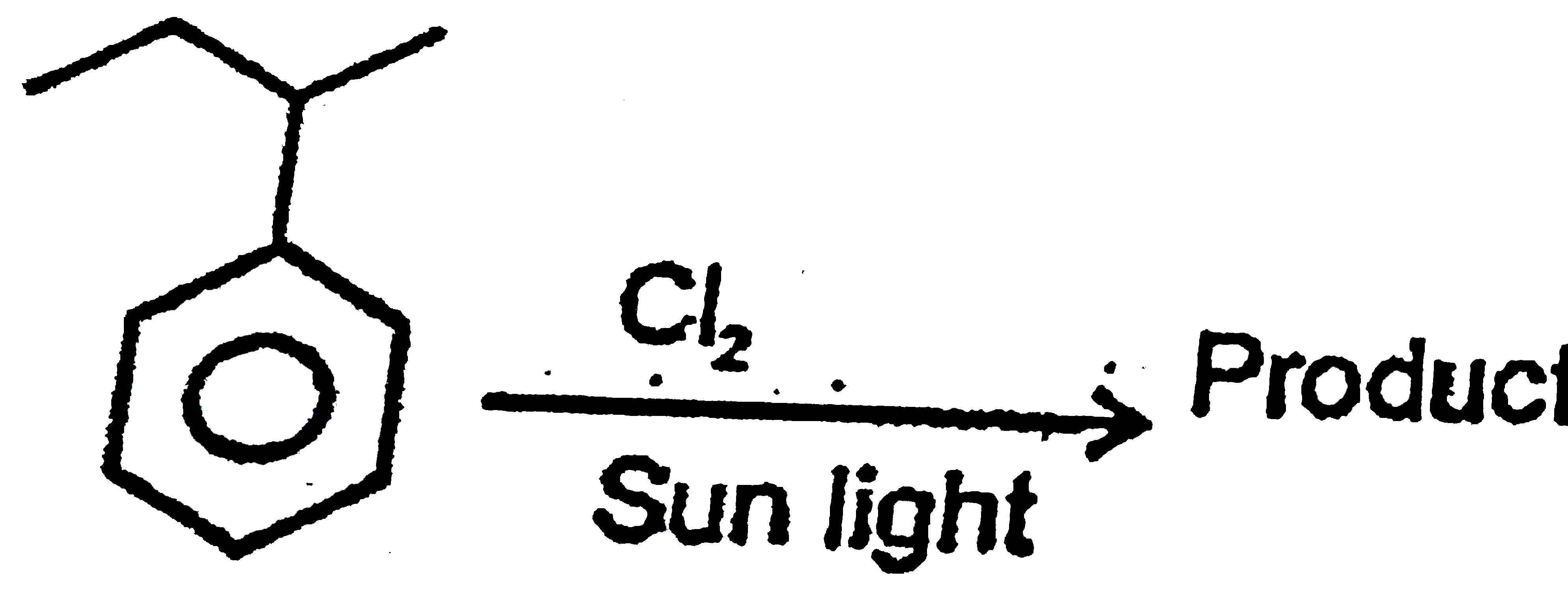What is the number of monochloro substituted derivatives formed from diphenyl methane?
The correct Answer is:4
To determine the number of monochloro substituted derivatives that can be formed from diphenylmethane, we will follow these steps:
Step 1: Understand the Structure of Diphenylmethane
Diphenylmethane consists of two phenyl (benzene) rings attached to a central methane (CH) group. The structure can be represented as follows:
CC6H5C6H5
Step 2: Identify Possible Substitution Sites
In diphenylmethane, there are several positions where chlorine (Cl) can be substituted:
1. The hydrogen atom on the central carbon (C) can be replaced by Cl.
2. The hydrogen atoms on the first phenyl ring can be replaced by Cl.
3. The hydrogen atoms on the second phenyl ring can be replaced by Cl.
Step 3: Analyze Substitution on Phenyl Rings
Each phenyl ring has 5 hydrogen atoms that can be substituted. However, due to the symmetry of the molecule, substituting chlorine on one ring will yield the same compound if substituted on the corresponding position of the other ring.
Step 4: Count Unique Monochloro Derivatives
1. Substitution on the central carbon:
- 1 derivative (C6H5-CHCl-C6H5)
2. Substitution on the first phenyl ring:
- 5 unique positions (C6H4Cl-CH-C6H5)
3. Substitution on the second phenyl ring:
- Since this is symmetrical to the first phenyl ring, it does not create new unique derivatives.
Thus, the total number of unique monochloro derivatives is:
- 1 (from central carbon) + 5 (from first phenyl ring) = 6 unique monochloro derivatives.
Final Answer
The number of monochloro substituted derivatives formed from diphenylmethane is 6.
---
Diphenylmethane consists of two phenyl (benzene) rings attached to a central methane (CH) group. The structure can be represented as follows:
In diphenylmethane, there are several positions where chlorine (Cl) can be substituted:
1. The hydrogen atom on the central carbon (C) can be replaced by Cl.
2. The hydrogen atoms on the first phenyl ring can be replaced by Cl.
3. The hydrogen atoms on the second phenyl ring can be replaced by Cl.
Each phenyl ring has 5 hydrogen atoms that can be substituted. However, due to the symmetry of the molecule, substituting chlorine on one ring will yield the same compound if substituted on the corresponding position of the other ring.
1. Substitution on the central carbon:
- 1 derivative (C6H5-CHCl-C6H5)
- 5 unique positions (C6H4Cl-CH-C6H5)
- Since this is symmetrical to the first phenyl ring, it does not create new unique derivatives.
- 1 (from central carbon) + 5 (from first phenyl ring) = 6 unique monochloro derivatives.
The number of monochloro substituted derivatives formed from diphenylmethane is 6.
Topper's Solved these Questions
- BOOK - FIITJEECHAPTER - GENERAL ORGANIC CHEMISTRYEXERCISE - NUMERICAL BASED QUESTIONS12videos
GENERAL ORGANIC CHEMISTRY
- BOOK - FIITJEECHAPTER - GASEOUS STATEEXERCISE - MATCHING LIST TYPE QUESTION1videos
GASEOUS STATE
- BOOK - FIITJEECHAPTER - HYDROCARBONSEXERCISE - SINGLE INTEGER ANSWER TYPE QUESTION9videos
HYDROCARBONS
Similar Questions
Knowledge Check
- Question 1 - Select One
The number of monochloro derivatives of isohexane is
A3B4C5D6 - Question 2 - Select One
Calculate the number of monochloro derivatives that formed when neo-pentane is chlorinated?
A1B2C3D4 - Question 3 - Select One

Number of monochloro structures in products isA3B4C6D7
The number of secondary monochloro derivatives of 2,3-dimethylbutane will be:
View Solution (Total number of monochloro structural products) View Solution
(Total number of monochloro structural products) View SolutionOf the isomeric haexanes, the isomers that give the minimum and maximum number of monochloro derivatives are, respectively,
View SolutionThe isomer of hexane that gives the minimum and maximum number of monochloro derivatives are respectively
View SolutionThe number of monochloro derivatives of isohexane is ( Only structural isomers )
View Solution



